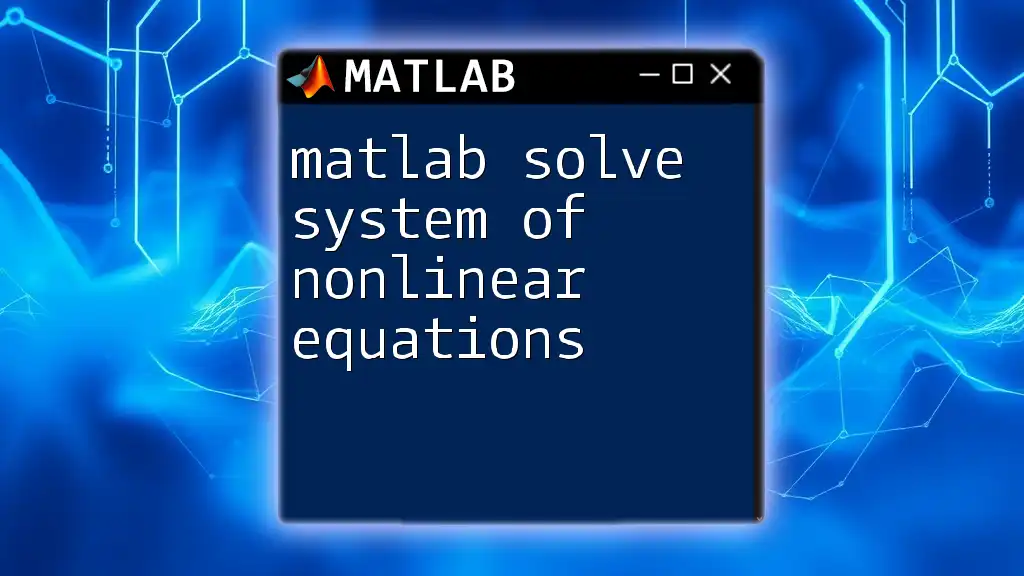To solve a system of nonlinear equations in MATLAB, you can use the `fsolve` function, which requires defining the equations in a separate function file or as an anonymous function.
Here’s a simple example of how to implement this using `fsolve`:
% Define the system of equations
fun = @(x) [x(1)^2 + x(2)^2 - 4; x(1) - x(2)^2];
% Initial guess for the solution
x0 = [1; 1];
% Call fsolve to solve the equations
solution = fsolve(fun, x0);
% Display the solution
disp(solution);
Understanding Nonlinear Equations
Definition of Nonlinear Equations
Nonlinear equations are those that do not form a straight line when graphed. They exhibit relationships in which the dependent variable \(y\) is not a linear function of the independent variable \(x\). This can include equations involving exponents, logarithms, trigonometric functions, or combinations thereof. For example, consider the equations:
- \(x^2 + y^2 = 4\) (a circle)
- \(x = y^3\) (a cubic curve)
Both of these equations illustrate the nonlinear nature of their relationships.
Characteristics of Nonlinear Systems
Unlike linear equations, nonlinear systems can exhibit a variety of solution behaviors:
- Multiple Solutions: Some systems may intersect at multiple points.
- No Solutions: Certain equations may never intersect, resulting in no solution.
- Unique Solutions: Occasionally, the equations may intersect at a single point.
These characteristics make solving nonlinear systems crucial in fields such as physics, engineering, and economics.

Setting Up the Problem in MATLAB
Defining the Equations
Before you can use MATLAB to solve a system of nonlinear equations, you need to express these equations in a way that MATLAB can understand. You can represent each equation as a function that outputs the difference from zero when the equations' conditions are satisfied.
Creating a Function
To solve these equations efficiently with MATLAB, it's essential to define a function. This function will encapsulate all the nonlinear equations in your system. Here’s how to set up a function for our example:
function F = myNonlinearSystem(x)
F(1) = x(1)^2 + x(2)^2 - 4; % Equation 1: Circle
F(2) = x(1) - x(2)^3; % Equation 2: Cubic
end
In this example, `myNonlinearSystem` accepts a vector `x` where \(x(1)\) and \(x(2)\) correspond to the variables of the system.

Solving Nonlinear Equations in MATLAB
Using `fsolve` Function
The `fsolve` function in MATLAB is specifically designed to find solutions for nonlinear equations. Here’s how to utilize it effectively:
- Initial Guess: Before calling `fsolve`, provide an initial guess for the solution. The initial guess acts as a starting point for the algorithm.
- Options: Adjust solver options for better performance and feedback.
Here’s an example that shows how to call `fsolve`:
% Initial guess
x0 = [1, 1];
% Calling fsolve
options = optimoptions('fsolve', 'Display', 'iter');
[solution, fval, exitflag, output] = fsolve(@myNonlinearSystem, x0, options);
In this script:
- `x0` is a vector that contains the initial guesses for the variables.
- The `options` structure is configured to display output during the solving process.
Interpreting Results
After executing the `fsolve` command, a few outputs are generated:
- solution: This is the vector containing the values of the variables that satisfy the equations.
- fval: The value of the nonlinear equations at the solution; ideally, these should be close to zero.
- exitflag: An integer indicating the exit status of `fsolve`, which informs you whether the solution was found successfully.
- output: Additional information about the optimization process, including iterations and function evaluations.
Understanding how to interpret these results is crucial for validation of the solution's accuracy and reliability.

Visualization of Solutions
Importance of Visualization
Visualizing solutions to nonlinear equations provides intuitive insights into where solutions lie and how they relate to one another. It allows you to confirm the results obtained from numerical solvers like `fsolve`.
Plotting Nonlinear Equations
MATLAB also provides powerful plotting functions to visualize equations. The following example demonstrates how to plot the previous system of equations:
% Plotting the first equation
fimplicit(@(x,y) x^2 + y^2 - 4, [-3, 3, -3, 3])
hold on;
% Plotting the second equation
fimplicit(@(x,y) x - y^3, [-3, 3, -3, 3])
% Highlighting solution
plot(solution(1), solution(2), 'ro')
xlabel('x-axis');
ylabel('y-axis');
title('Solutions of Nonlinear Equations');
legend('x^2 + y^2 = 4', 'x = y^3', 'Solution');
hold off;
In this code:
- The `fimplicit` function is used to plot the implicit equations efficiently.
- The obtained solution is highlighted using a red circle, making it visually clear where the two equations intersect.

Common Challenges and Troubleshooting
Issues with Nonlinear Solving
While occasionally straightforward, solving nonlinear equations often presents challenges. Common pitfalls include:
-
Choosing an Unreasonable Initial Guess: Nonlinear systems can be sensitive to the initial guess provided. Incorrect guesses can lead to failure in finding solutions or convergence to the wrong point.
-
Equations That Are Too Complex: If the equations are too complex, the solver may have difficulty converging to a solution.
Troubleshooting with MATLAB Tools
To enhance the performance of `fsolve`, leverage diagnostic tools like `optimset`. You can adjust settings that specify tolerances and maximum iterations. Here’s an example of setting properties to enhance solver performance:
options = optimset('TolFun', 1e-6, 'MaxIter', 400);
[solution, fval, exitflag] = fsolve(@myNonlinearSystem, x0, options);
In this snippet, `TolFun` specifies the tolerance for the function value, while `MaxIter` limits the maximum number of iterations.

Advanced Techniques
Using Symbolic Math Toolbox
If you prefer an analytical approach, the Symbolic Math Toolbox in MATLAB can be used. This allows you to view the equations symbolically, leading to exact solutions when possible. Here's how you can use the `solve` function:
syms x y
eq1 = x^2 + y^2 == 4;
eq2 = x == y^3;
[sol_x, sol_y] = solve([eq1, eq2], [x, y]);
In the above code, `sol_x` and `sol_y` yield symbolic solutions when the equations are solvable analytically.
Complex Systems and Multiple Solutions
Handling complex systems requires a nuanced approach. In cases where multiple solutions are possible, you may need to explore different initial guesses or apply parameter sweeps to identify all potential solutions.

Conclusion
Mastering how to matlab solve systems of nonlinear equations is an essential skill for various scientific and engineering applications. By developing a robust methodology for defining equations, utilizing effective solvers like `fsolve`, and harnessing visualization tools, you can efficiently tackle nonlinear problems. As you continue your MATLAB journey, practice with diverse examples and explore MATLAB’s extensive documentation for maximum proficiency.

Additional Resources
For further learning, explore the MATLAB documentation related to `fsolve`, review online courses focused on optimization, and check recommended books and articles on numerical methods. Engaging with the MATLAB community can also provide valuable insights and real-world applications.

Call to Action
Stay tuned for more tips and tricks on MATLAB to increase your proficiency in computational mathematics. Share your experiences or questions in the comments below, and let’s foster a community of learning together!

















